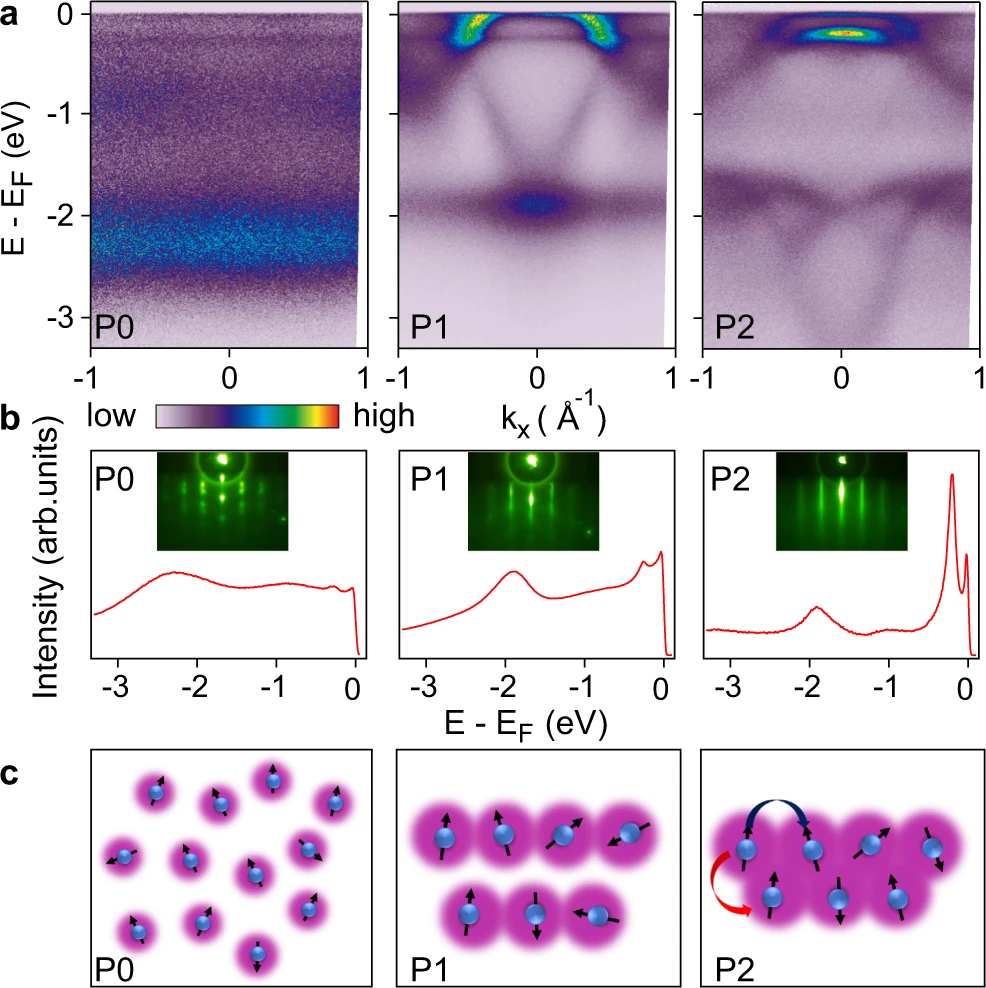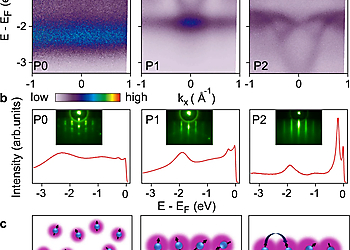Bandwidth-Control Orbital-Selective Delocalization of 4f Electrons in Epitaxial Ce Films
Result of the Month

Figure Description: Electronic structure of a thick Ce film at 20 K after progressive post-growth annealings from ~370 to ~540 K. a Three representative ARPES spectra at different stages of annealings: disordered Ce film (P0), ordered Ce films at intermediate annealing temperature (P1), and at high annealing temperature (P2). b Energy distribution curves (EDCs) at the Γ point for these three phases. The insets are the corresponding RHEED images. c Cartoons illustrating the proposed origin of the different electronic structures. The reduction of the interlayer spacing in P2 is exaggerated.
MBE Growth & Annealing
Ce films were grown on top of epitaxial graphene layers at a temperature of approx. 100 °C and at a rate of 2 Å/min using a high-temperature effusion cell of a Lab10 MBE. The Ce films were sequentially annealed from 370 to 540 K.
ARPES Measurements
Samples were immediately transferred in UHV from the MBE chamber to a connected ARPES Lab equipped with a DA30-L analyser and a VUV5k He lamp. Measurements were conducted at a sample temperature of 20 K and at an operating pressure of 2.3 × 10−10 mbar. The pass energy was set to 10 eV yielding approx. 15 meV energy resolution.
Authors
Yi Wu, Yuan Fang, Peng Li, Zhiguang Xiao, Hao Zheng, Huiqiu Yuan, Chao Cao, Yi-feng Yang, Yang Liu
Institutes
- Center for Correlated Matter and Department of Physics, Zhejiang University, Hangzhou, China.
Yi Wu, Yuan Fang, Peng Li, Zhiguang Xiao, Hao Zheng, Huiqiu Yuan, Yang Liu
- Zhejiang Province Key Laboratory of Quantum Technology and Device, Zhejiang University, Hangzhou, China.
Huiqiu Yuan, Yang Liu
- Collaborative Innovation Center of Advanced Microstructures, Nanjing University, Nanjing, China.
Huiqiu Yuan, Yang Liu
- Department of Physics, Hangzhou Normal University, Hangzhou, China.
Chao Cao
- Beijing National Laboratory for Condensed Matter Physics, Institute of Physics, Chinese Academy of Sciences, Beijing, China.
Yi-feng Yang
- School of Physical Sciences, University of Chinese Academy of Sciences, Beijing, China.
Yi-feng Yang
- Songshan Lake Materials Laboratory, Dongguan, Guangdong, China.
Yi-feng Yang
Corresponding Authors
Yi-feng Yang: yifeng@iphy.ac.cn
Yang Liu: yangliuphys@zju.edu.cn
Publicaton: Wu, Y., Fang, Y., Li, P. et al. Bandwidth-control orbital-selective delocalization of 4f electrons in epitaxial Ce films. Nat Commun 12, 2520 (2021). https://doi.org/10.1038/s41467-021-22710-2

